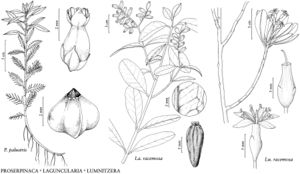Difference between revisions of "Laguncularia racemosa"
Suppl. Carp., 209. 1807.
imported>Volume Importer |
imported>Volume Importer |
||
| Line 53: | Line 53: | ||
|publication year=1807 | |publication year=1807 | ||
|special status= | |special status= | ||
| − | |source xml=https://xjsachs2@bitbucket.org/aafc-mbb/fna-data-curation.git/src/ | + | |source xml=https://xjsachs2@bitbucket.org/aafc-mbb/fna-data-curation.git/src/e39f0e846f172941159b2045254d62d10d9823f6/coarse_grained_fna_xml/V10/V10_672.xml |
|genus=Laguncularia | |genus=Laguncularia | ||
|species=Laguncularia racemosa | |species=Laguncularia racemosa | ||
Latest revision as of 10:33, 9 May 2022
Shrubs or trees to 10(–20) m. Leaves: petiole 6–15 mm; blade ovate to obovate, oblong, or suborbiculate, 2–9.7 × 1.4–5 cm, base obtuse to rounded, folded longitudinally when young, with a faint longitudinal line each side of midvein in age. Spikes (or spicate units of panicles), 2–13 cm. Flowers: sepals 1 mm; stamens 1.5–2 mm; style 1–2 mm. Drupes greenish or gray-green [reddish green], 13–20 × 5–9 mm, pubescent [glabrous].
Phenology: Flowering spring–early summer.
Habitat: Tidal swamps, mangrove communities.
Elevation: 0 m.
Distribution
Fla., Tex., e Mexico, West Indies, Central America, South America, w Africa.
Discussion
Laguncularia racemosa is an important component of mangrove swamps in central and southern Florida (extending northward to Levy County on the Gulf Coast and to Volusia County on the Atlantic Coast); it also recently has been reported from Willacy County, Texas. The species is occasionally cultivated as an ornamental tree or shrub in coastal situations. The flowers are quite fragrant and are pollinated by bees. The fruits are semiviviparous, the green embryo piercing the seed coat while the fruit is still on the tree. Some populations have some plants with bisexual flowers and others with staminate flowers, while in others all flowers are bisexual. The frequency of staminate plants in Florida is variable (0–68%).
Selected References
None.
